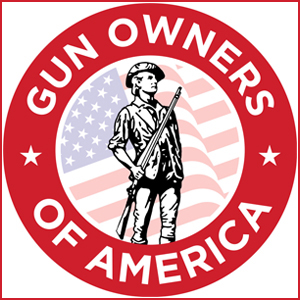The .44 Special Begins Its Second Century - Part I
by John Taffin
Summary
In an age of magnums and larger caliber handguns, the .44 Special is just as relevant for today's shooters and hunters as it was in Elmer Keith's days. In this article from Gun Digest 2010, sixgun expert John Taffin shows this cartridge is still up to task. And with so many models still chambered in .44 special, there's plenty of reasons to champion the round.
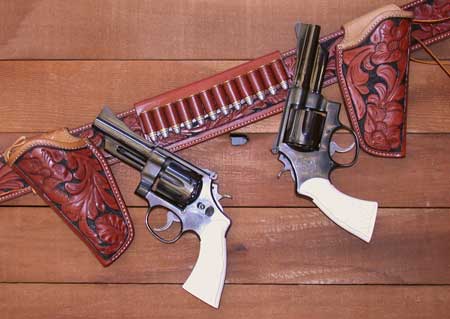
In the early 1980s S&W resurrected the .44 Special Model 24 for a limited run. This matched pair of 4" sixguns wear carved ivory stocks by Bob Leskovec and are carried in floral carved Tom Threepersons holsters from El Paso Saddlery.
In 1857, two entrepreneurs, Horace Smith and Daniel Wesson, produced the first successful cartridge-firing revolver, the Smith & Wesson #1. This little seven-shot, tip-up revolver was chambered for what would become the most popular cartridge of all time, the .22 rimfire. They would go on to build both .22 and .32 rimfires in the Models 1, 1-1/2, and 2, and they had plans to bring out a big-bore version, but those plans were pushed to the back burner with the coming of the Civil War in 1861.
Meanwhile, over at the Colt factory, Sam Colt had decided cartridge cases would never catch on and shooters would always want to load their own using powder, ball, and cap.
When Colt received a very lucrative contract to build 1860 Army Model .44s for the Northern Army not, only was the company¹s immediate future assured but there definitely was no further thought of building cartridge-firing revolvers. Smith & Wesson kept producing their little pocket guns, which were quite popular as hideout weapons during the 1860s, but they did not forget their plans to build a .44-caliber version.
Sam Colt died in 1862, but his ideas persisted and percussion revolvers remained as the number one focus of the Colt Company. Then it happened! I can let my imagination run loose and see the executives of Colt sitting around the boardroom in late 1869 when the messenger arrives. He talks to the president, Richard Jarvis, who immediately scowls. He shares the information with the rest of the group. That other gun company, that Smith & Wesson group, had just announced a large-frame, break-top, six-shot, cartridge-firing .44 sixgun!
The new Smith & Wesson was known as the American and was chambered in both .44 Centerfire and .44 Henry Rimfire. Then when the U.S. Army ordered 1,000 .44 S&W Americans, Colt really knew they had some catching up to do.
Meanwhile, someone else was taking a serious look at the first .44 from Smith & Wesson: the Russians. They eventually negotiated a large contract for 150,000 guns with the Springfield firm to supply single-action sixguns for the Czar¹s army.
However, they insisted on a change in the ammunition that would affect all future cartridge-cased ammunition. The original .44 S&W American was made just like the .22 Rimfire and used an outside lubricated heel bullet; that is, the diameter of the main body of the bullet was the same as the diameter of the outside of the brass case, but the lower part of the bullet was slightly smaller in diameter to fit inside the cartridge case.
The Russians made a great improvement in ammunition when they asked for a bullet of uniform diameter with lube grooves inside the case itself. The result was the .44 Russian and the beginning of modern ammunition.
Those first Russian contract guns were nothing more than American models chambered in .44 Russian. Eventually the rounded back strap was changed with a hump at the top to prevent the grip¹s shifting in the hand when the gun was fired, and a spur was placed on the bottom of the trigger guard. (The argument still remains as to just what that spur was for: to parry a sword thrust? To keep the sixgun from falling when carried in a sash? To serve as a steadying rest for the middle finger when firing the revolver? All these theories have been advanced.) This sixgun became known as the Model #3 Russian.
With the removal of the spur and a slightly redesigned grip frame, the Model #3 Russian evolved into the New Model #3 in 1878 chambered in, of course, .44 Russian. The New Model #3 is without a doubt the epitome of Smith & Wesson single action production, and could easily be argued as the finest single-action sixgun to come from the nineteenth century. It was beautifully built with tight tolerances that actually worked against it in a black powder age with the fouling resulting from shooting.
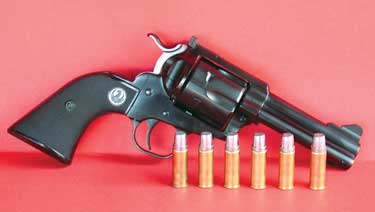
by John Taffin
Summary
In an age of magnums and larger caliber handguns, the .44 Special is just as relevant for today's shooters and hunters as it was in Elmer Keith's days. In this article from Gun Digest 2010, sixgun expert John Taffin shows this cartridge is still up to task. And with so many models still chambered in .44 special, there's plenty of reasons to champion the round.

In the early 1980s S&W resurrected the .44 Special Model 24 for a limited run. This matched pair of 4" sixguns wear carved ivory stocks by Bob Leskovec and are carried in floral carved Tom Threepersons holsters from El Paso Saddlery.
In 1857, two entrepreneurs, Horace Smith and Daniel Wesson, produced the first successful cartridge-firing revolver, the Smith & Wesson #1. This little seven-shot, tip-up revolver was chambered for what would become the most popular cartridge of all time, the .22 rimfire. They would go on to build both .22 and .32 rimfires in the Models 1, 1-1/2, and 2, and they had plans to bring out a big-bore version, but those plans were pushed to the back burner with the coming of the Civil War in 1861.
Meanwhile, over at the Colt factory, Sam Colt had decided cartridge cases would never catch on and shooters would always want to load their own using powder, ball, and cap.
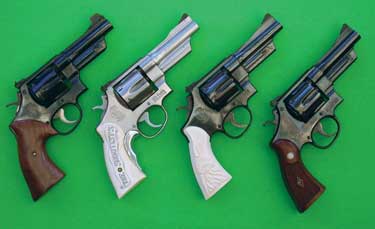 Smith & Wesson 4" .44 Specials: 1950 Target with shortened barrel, Model 624, Model 24- 3, and original 4" 1950 Target. |
Sam Colt died in 1862, but his ideas persisted and percussion revolvers remained as the number one focus of the Colt Company. Then it happened! I can let my imagination run loose and see the executives of Colt sitting around the boardroom in late 1869 when the messenger arrives. He talks to the president, Richard Jarvis, who immediately scowls. He shares the information with the rest of the group. That other gun company, that Smith & Wesson group, had just announced a large-frame, break-top, six-shot, cartridge-firing .44 sixgun!
The new Smith & Wesson was known as the American and was chambered in both .44 Centerfire and .44 Henry Rimfire. Then when the U.S. Army ordered 1,000 .44 S&W Americans, Colt really knew they had some catching up to do.
Meanwhile, someone else was taking a serious look at the first .44 from Smith & Wesson: the Russians. They eventually negotiated a large contract for 150,000 guns with the Springfield firm to supply single-action sixguns for the Czar¹s army.
However, they insisted on a change in the ammunition that would affect all future cartridge-cased ammunition. The original .44 S&W American was made just like the .22 Rimfire and used an outside lubricated heel bullet; that is, the diameter of the main body of the bullet was the same as the diameter of the outside of the brass case, but the lower part of the bullet was slightly smaller in diameter to fit inside the cartridge case.
The Russians made a great improvement in ammunition when they asked for a bullet of uniform diameter with lube grooves inside the case itself. The result was the .44 Russian and the beginning of modern ammunition.
Those first Russian contract guns were nothing more than American models chambered in .44 Russian. Eventually the rounded back strap was changed with a hump at the top to prevent the grip¹s shifting in the hand when the gun was fired, and a spur was placed on the bottom of the trigger guard. (The argument still remains as to just what that spur was for: to parry a sword thrust? To keep the sixgun from falling when carried in a sash? To serve as a steadying rest for the middle finger when firing the revolver? All these theories have been advanced.) This sixgun became known as the Model #3 Russian.
With the removal of the spur and a slightly redesigned grip frame, the Model #3 Russian evolved into the New Model #3 in 1878 chambered in, of course, .44 Russian. The New Model #3 is without a doubt the epitome of Smith & Wesson single action production, and could easily be argued as the finest single-action sixgun to come from the nineteenth century. It was beautifully built with tight tolerances that actually worked against it in a black powder age with the fouling resulting from shooting.

In 1881, Smith & Wesson looked at that beautiful New Model #3 and redesigned it with a double-action mechanism, and so the first Double Action Model arrived in .44 Russian. These are not the finest-looking double-action sixguns ever made, far from it, but they were dependable and would represent the best big-bore double-action sixguns from Smith & Wesson for more than 25 years. In fact, the Double Action .44 would stay in production right up to the eve of World War I.
By the late 1890s, Colt was producing swing-out cylindered double-action revolvers, and Smith & Wesson soon followed suit. In 1899, Smith & Wesson produced their first K-frame, the Military & Police, which would go on to be one of the most popular revolvers of the twentieth century. It was chambered in .38 Special, but the engineers at Smith & Wesson were looking at something a bit bigger.
In 1907, the Military & Police was enlarged to what we now know as the N-frame, fitted with an enclosed ejector rod housing, and had a third locking mechanism added. By this time, the M&P locked at the back of the cylinder and the front of the ejector rod; this new sixgun received a third lock with the crane locking into the back of the ejector rod housing.
The new sixgun had many names, including the .44 Hand Ejector 1st Model, New Century, Model of 1908, .44 Military, but it is best known among collectors and shooters alike as the Triple Lock. Such a beautifully built sixgun deserved a new cartridge, and that cartridge was the .44 Special.
To arrive at the .44 Special, the .44 Russian was sicmply lengthened from .97" to 1.16". But having gone to the edge of perfection, Smith & Wesson then drew back. The longer cartridge in a stronger sixgun was loaded to duplicate the .44 Russian!
The Russian carried a bullet of approximately 250 grains at a muzzle velocity of about 750 fps. They should have at least duplicated the .45 Colt round and bumped the .44 Special up to 850-900 fps and 1,000 fps would have been even better. It would remain the task of experimenters in the 1920s through the 1940s to discover the real potential of the .44 Special.
Click here to read Part II
To get 65 years' worth of Gun Digest articles on 3-DVDs over 3,000 gun stories dating back to 1944 Click here.
By the late 1890s, Colt was producing swing-out cylindered double-action revolvers, and Smith & Wesson soon followed suit. In 1899, Smith & Wesson produced their first K-frame, the Military & Police, which would go on to be one of the most popular revolvers of the twentieth century. It was chambered in .38 Special, but the engineers at Smith & Wesson were looking at something a bit bigger.
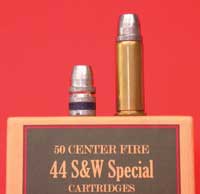 The most popular bullet for the .44 Special is the Keith design; this version is from RCBS. |
The new sixgun had many names, including the .44 Hand Ejector 1st Model, New Century, Model of 1908, .44 Military, but it is best known among collectors and shooters alike as the Triple Lock. Such a beautifully built sixgun deserved a new cartridge, and that cartridge was the .44 Special.
To arrive at the .44 Special, the .44 Russian was sicmply lengthened from .97" to 1.16". But having gone to the edge of perfection, Smith & Wesson then drew back. The longer cartridge in a stronger sixgun was loaded to duplicate the .44 Russian!
The Russian carried a bullet of approximately 250 grains at a muzzle velocity of about 750 fps. They should have at least duplicated the .45 Colt round and bumped the .44 Special up to 850-900 fps and 1,000 fps would have been even better. It would remain the task of experimenters in the 1920s through the 1940s to discover the real potential of the .44 Special.
Click here to read Part II
To get 65 years' worth of Gun Digest articles on 3-DVDs over 3,000 gun stories dating back to 1944 Click here.







